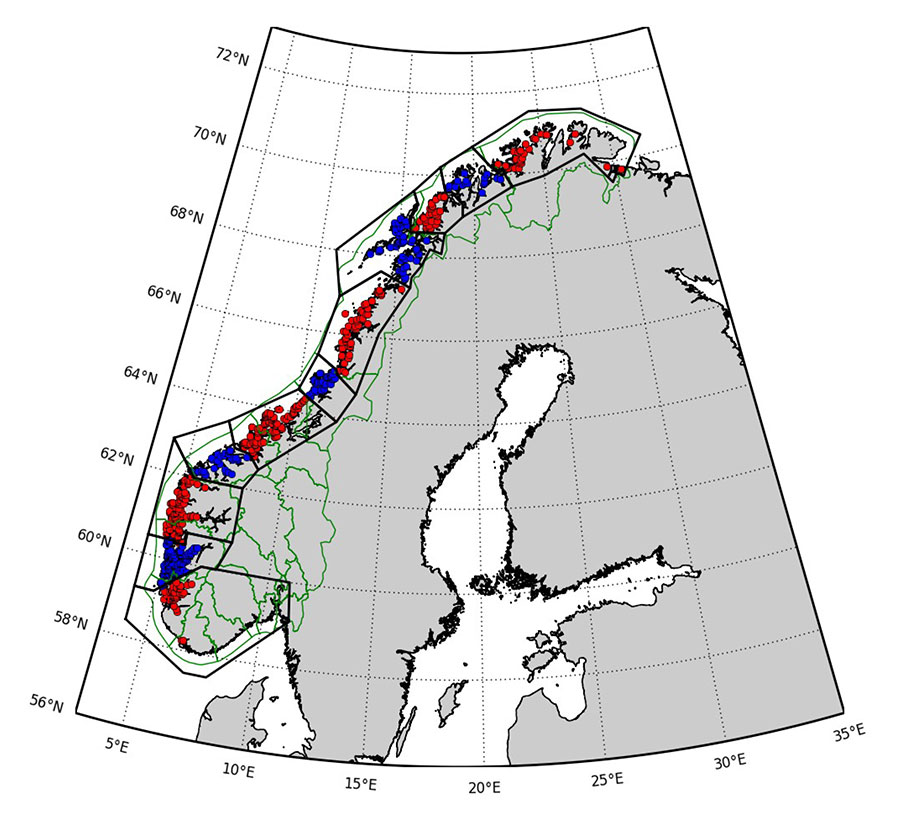Norway case study
In Norway the Atlantic salmon (Salmo salar L.) and rainbow trout (Oncorhynchus mykiss) farming industry has grown to become one of the country’s largest export industries by economic value. In 2014, the production of Atlantic salmon and rainbow trout was 1 258 356 and 68 910 tons, respectively, at a total of 994 locations.
A major sustainability issue in salmon aquaculture is on farmed fish acting as hosts for the natural parasite salmon louse (Taranger et al., 2015). With more than 500 times farmed salmon compared to wild salmonid fish, salmon lice have become a potential problem for the latter. Sustainable growth of aquaculture, which is an expressed goal of the Norwegian authorities, is limited by the potential negative influence on the environment and natural ecosystem affecting spatial issues in management, like site selection and zoning.
Operational salmon lice dispersion model
Environmental goals set by the governmental “Strategy for an environmentally Sustainable Norwegian Aquaculture Industry” from 2009 stated a location structure and zoning which reduces impact on the environment and the risk of infection. This was followed up by an expert committee report in 2011, on new measures to allocate area for sustainable aquaculture development (Gullestad et al., 2011) including the suggestion on establishing zoning and production areas where farming activity, production level and allocation of area should be regulated based on environmental impact measures. The plan for implementation was given as part of a White paper in 2015 on “Predictable and environmental sustainable growth of the Aquaculture industry” (Anon. 2015), and IMR was requested to provide the fundament for positioning of the zoning.
The case study is based on the operational modeling tool that provides weekly data on abundance of infective salmon lice along the Norwegian coast. Its primary goal is to give a geographical overview of infestation pressure from salmon lice on wild fish, also assessing siting of farms and on a larger spatial scale suggesting production zoning. Recently, a connectivity analysis based on sea lice dispersion along the entire coast has been used to suggest positioning of the “fire brake” areas and the eleven production zones requested as part of the follow up of the White paper and planned to be implemented for future management scheme of Norwegian salmonid aquaculture (planned implemented 2017). The intention is primarily to use measures and indices on impact from salmon lice on the wild salmonids to regulate production level in the zones.
The connectivity analysis is based on a matrix of influence giving an estimate of the potential sea lice infection between pair of existing farms along the entire coast, separated in two “dimensions” being a source or target for infection pressure. This makes the fundament for suggestions on where to position “fire brakes” to make up for the requested 11-13 zones along the coast, or alternatives (Ådlandsvik, 2015).
 Figure 1. Suggested positions (black line) of “fire brakes” to make up the requested 11-13 zones for management of production levels of salmonid farming. Red and blue dots are existing locations (from Ådlandsvik, 2015).
Figure 1. Suggested positions (black line) of “fire brakes” to make up the requested 11-13 zones for management of production levels of salmonid farming. Red and blue dots are existing locations (from Ådlandsvik, 2015).
Stakeholder meeting
As part of the plan for implementation of production areas given in the White paper on “Predictable and environmental sustainable growth of the Aquaculture industry”, the suggestion on zoning given by IMR and responses from the industry a series of stakeholder meetings are carried out. A dialogue meeting between IMR, the Norwegian Food Safety Authority and industry representatives were held on 25 November 2015. Related meetings on the zoning issue were hosted by the Norwegian Seafood Federation on 16 October and 10 November 2015. Aquaspace will co-host an international meeting on salmon lice dispersion modeling in April 2016. Internal meeting at IMR on coordination of spatial planning tools along the line of the Aquaspace objectives were carried out 8-19 November 2015.
References
Anon. 2015. Predictable and environmental sustainable growth of the Aquaculture industry (in Norwegian). Meld. St. 16 (2014-2015), Ministry of Trade and Fisheries, Oslo, Norway.
Gullestad P., Bjørgo S., Eithun I., Ervik A., Gudding R., Hansen H., Røsvik I. O., et al. 2011. Effective and sustainable use of areas for aquaculture – land of desire (in Norwegian). Report from an expert panel appointed by Ministry of Fisheries and Coastal Affairs, Oslo, Norway. 198 pp.
Taranger, G.L., Karlsen, Ø., Bannister, R.J., Glover, K.A., Husa, V., Karlsbakk, E., Kvamme, B.O., Boxaspen, K.K., Bjørn, P.A., Finstad, B., Madhun, A.S., Morton, H.C. & Svåsand, T. 2015. Risk assessment of the environmental impact of Norwegian Atlantic salmon farming. ICES Journal of Marine Science, 72: 997-1021.
Ådlandsvik, B. 2015. Suggestion on zoning of production areas (in Norwegian). Fisken og Havet, report no 20.
